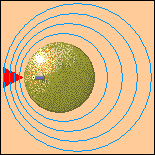- Hypostases of the existence vector.
The "force" hypostasis is complex. It possesses binary,
polar qualities and it evolves by combinations, from the electric and magnetic
phenomena to atoms, bodies, vortex, orbit, instincts, feelings, consciousness,
etc. All the forms under which we know it, are reduced to attraction or
repulsion forces (composition or decomposition, good or evil, etc.)
It is not gravity which attracts bodies! Bodies "do not generate gravitational
field". Bodies are "vectors
in package". The gravitational field is "bulk vectors".
It mediates the extension of interaction (polarity) by ordering in a series
its own vectors, between the open polarities of bodies, like with the propagation
of waves. The Forces with which the earth attracts the bodies, weight,
are the same forces which connect atoms! Forces of open "extended"
polarities (attraction thread between polarities ordered in a series).
To these is added the centripetal force of pressing, compression,
of the electric field, induced in the gravitational field by its rotation
movement. How?
The body found in rotation movement "winds the extended threads of
polarities" (like the arms of galaxies) and forms an electric field
closed around itself, that propagates towards the center with velocity "c"!
It gives the centripetal force which accelerates rotation and curves
the "linear" movement of planets, by means of the vectorial composition
of the two fields - the orbit.
Other hypostases: The polarities of particles on the surface of a body found
in motion, induce the orientation of the vectors of the gravitational field
in the direction of linear or circular movement, in the electrical hypostasis,
and the magnetic hypostasis in transversal plane. It is the inertial movement.
Effects: 1) Conservation of motion (of the orientation of the electric field).
2) If an external force modifies the motion of the body, the electric field
resists by means of its reaction force (modification of the orientation
density - of the field density). 3) In the case of circular motion, the
same reaction force resists the inclination of the rotation axis,
adding a new component to the motion - precession. The new component can
be stable, or it can oscillate in the plane of inclination of the rotation
axis - nutation. These phenomena are dependent on the properties of the
environment, of the body and on the parameters of motion. They are interactions
with "the motion of motion" and have specific effects (reflection,
the Doppler effect, migration of poles).




